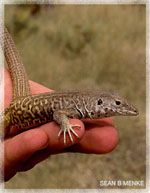Lizard ecology
Lizard community ecology in the Chihuahuan Desert
The organization and structure of animal communities occurring across ecotones and more specifically habitat edges have important implications for conservation and wildlife management. An ecotone is the change in the vegetative structure between adjacent communities or biomes. The edge caused by this transition may be critical to ecosystem and landscape function. Anthropogenic edge effects have been widely studied for their negative effects on abundance and structure of animal communities. These negative effects are caused by a variety of factors, such as increased levels of disturbance, high abundance and diversity of exotic species, and altered microclimates. Transitions between natural habitat types are subject to many of the same edge effects (increased disturbance and altered microclimates). An understanding of how animal communities change across natural edges will help determine what factors are most important in the modern fragmented urban landscape.
I investigated the distribution and abundance of lizard species across a natural desert grassland – creosote bush (Larrea tridentata) ecotone in the Chihuahuan desert of New Mexico. This ecotonal area has increased dramatically in the past 150 years at the Jornada LTER where I conducted my study because of the rapid spread of creosote bush. I asked four related questions: 1) how large and 2) where is the ecotone based on vegetative structure, and 3) do lizard abundance and 4) diversity change across the ecotone? This particular ecotone is very abrupt and separates two very distinct desert ecosystems. During two summers, 677 individual lizards of 9 genera and 12 species were captured. Lizard abundance increased with increasing distance from the ecotone into either habitat and was similar in grassland and creosote bush habitat. Grasslands had higher species richness than both the creosote bush and ecotone habitats. Grassland sites had greater habitat heterogeneity than did creosote bush sites. The ecotone had less canopy cover and larger areas of bare ground than either habitat. No ecotone specialist species were detected, and all common lizard species could be found in each habitat. Three potential explanations for decreased abundance in the ecotone are presented: (1) increased risk of predation, (2) decreased prey abundance, and (3) lack of species-specific microhabitat requisites.
PDF - Lizard community structure across a grassland/creosote shrubland ecotone in the Chihuahuan Desert

